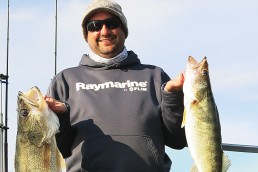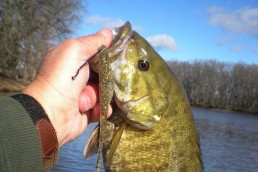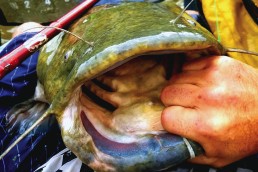Speedy Spinners
SHARE THIS POST
Speed and using spinners for walleyes sounds like a direct contradiction. But running spinners, typically baited with nightcrawlers, has always been a tedious affair. The standard is to drag them up and down structural elements with the weighting system of a bottom bouncer, ranging from 1 ounce on up to 3 or even 4 ounces, depending upon depth and wind conditions.
This has become a staple on the large windswept reservoirs of the Dakotas where the technique was born and has been ultimately perfected. Another technique that was developed and fine-tuned on these same reservoirs is the slow-death method. Basically, it’s a kinked, fine-wire, Aberdeen-style hook that slow-rolls half a ’crawler. It’s seductively simple and downright deadly when properly presented.
As simple and as effective as this is, it can be made even better with some tinkering. After a couple of seasons of trial and error, I developed what is now the Slow Death Plus line for JB Lures. It uses a standard Mustad Slow Death hook and incorporates a 4-mm bead followed by a contrasting colored 8-mm bead, and then a small aircraft-style propeller blade. This gives the rig a slightly bulkier profile. And combined with the color and slight flicker and flash of the blade, it serves to make the whole package even more deadly. There are versions with floats and even a two-hook harness where the worm is threaded directly onto the line.
Now, through extensive testing, I’ve taken the next logical step to come up with the Super Death Plus Spinner Series. It combines the proven rolling action of slow-death rigs and further enhances it by incorporating the time-honored thump and flash of a spinner rig.
This is accomplished by using a slightly bigger, stouter hook in the form of the Mustad Super Slow Death. This holds up much better to the hard strikes that it will elicit at higher speeds and is well suited to hold the trophies The Great Lakes kick out. I’ve followed this up with the size 2 Matzuo Sickle hooks. I also do something a bit interesting: I use either a whole ’crawler or an artificial from Gulp. If you weren’t at least experimenting with artificial baits before, I’d strongly urge you to do so.
I run the head end of the nightcrawler onto the slow-death hook in a traditional fashion. I don’t impede its natural action by impaling it with the sickle hooks. The result is an incredibly natural and nearly irresistible motion. Not hooking our bait seems counterintuitive, but trust me on this, once you run it beside the boat you will instantly see why it’s best deployed in this fashion. The whole ’crawler rolls uninhibited and has an eerily realistic snaking action and the hooks are running right there with it.
Are you enjoying this post?
You can be among the first to get the latest info on where to go, what to use and how to use it!
When a fish overtakes a rig these hooks easily swing into its mouth and immediately finds a meaty home. The hook-up ratio with this rig is over 90 percent. It will soon become apparent that the bites are bigger too. I feel this is due to the entire ’crawler stretching out completely, making for a larger overall profile. Mature fish are selective feeders and will find this more appealing. I’m also a proponent of running large number 5 blades for that very same purpose. Should you feel a need to scale this down a bit, there’s a single-hook Super Death Plus version. Or you can use the quick-change clevis and snap in a smaller number 3 Ventilator blade. Versions can be had in either a size 3 or 5 blade with quick-change clevises for flexibility, depending on conditions. It has two vents incorporated into a Colorado-style blade, and the commotion and change in pressure created by water being forced through the vents transmits a feel of vulnerability to the fish. Furthermore, the vents create a sort of gyroscopic stabilizing effect on the whole rig at higher speeds. The speed at 1.5 mph is typically thought of as the upper end for pulling spinners. This is where the Ventilator blade begins to shine as it can be run up to and beyond 3 mph without them blowing out.
This presentation is well suited for quickly covering ground on large flats or tapering shorelines. What I like to do before ever wetting a line is to make a couple of 30-mph runs up and down the structure using trim tabs to keep the nose down on my Lund to get a safe and quick, yet thorough dissemination of the presence of fish, baits and any depth or structural elements they’re relating to. I’ll use multi-function displays of the Raymarine coupled with the accuracy of Navionics background mapping.
Once I find an area with decent prospects, I’ll start out near 1.8 mph, but you can play with speeds up to 3 mph to determine if there’s a decided preference. A typical setup can include more than just the spinner option too. Assuming three anglers are in the boat, I’ll send planer boards out. I’ll then suspend a big aggressive bait like an 800 Deep Reef Runner, and on the inside, either a Super Death spinner behind an inline weight or a smaller shad-bodied crankbait tight to shore. I use 10-foot Eyecons too, which can be run with spinners and medium-weight snap weights or I use a crank like the Deep Little Ripper straight out the sides. Off the stern, a 7-foot 6-inch rod can then run a heavy snap weight, basically in the prop wash, with a spinner. The other side sports a 5-inch “shorty” leadcore rod with a diminutive crankbait like a number 4 Salmo Hornet or a Mini Ripper to balance it all out. In effect, we’ve set out a buffet line of baits and have spread them over a large swath of varying depths. We’re quite literally seining the water for bites. On some days you will see all the rods get their share of bites, while on other days a pattern will soon develop and you can adapt as needed.
For line, you can choose mono or braid depending on the depth. I personally keep my line selection simple with 10-pound-test FireLine or 12-pound-test Nano (at same diameters). For mono, the standard, reliable Trilene XT in 10-pound-test is ideal. I prefer mono in 10 feet or less, and use superline beyond that. Mono in shallower water allows us to get our weighting systems and baits a bit farther back from the boat and the stretch it provides allows us a little cushion for what are often viscous turn-and-run bites in the shallows. In deeper waters, the thin diameter and low-stretch qualities of braid allow us to keep our baits within a controllable distance without going to unreasonable amounts of weight. Play around with the options until you come up with a program that works.
A spinner blade size can play a significant role too. The saying that big blades are only for big waters like The Great Lakes has some truth to it, but this is far from being definitive. Big blades, like number 5s, can perform just fine in smaller waters, particularly in the heat of summer. They can also be beneficial if you’re dealing with a lot of panfish and cigar-sized walleyes. Bigger blades coupled with artificial ’crawlers will help deter them to some extent. Also keep in mind that we are not approaching this from a finesse standpoint; we’re deploying a bold and brash presentation specifically designed to target the largest, most active fish an area holds. When done properly and when dealing with aggressive fish, it can be the difference between an average day and one that averages big fish. If you’re encountering tentative fish with a neutral to negative attitude, it takes but a second to snap in a more diminutive size 3 blade and see if that improves the situation.
I have a well-deserved reputation for being a non-conformist. I whole-heartedly embrace this and fully realize that I’ve covered a lot of “questionable” ground here—many of you may be asking yourselves some questions. But pick and choose to use as much or as little as I have shared here. I do believe you will start to open some eyes, including yours and the ’eyes as well, in the process. Besides, what’s the fun in always doing something that’s an accepted practice?
MWO
SHARE THIS POST
Did you enjoy this post?
You can be among the first to get the latest info on where to go, what to use and how to use it!
Dennis Foster
Dennis Foster owns and operates Dakota Pheasant Guide, writes informative hunting and fishing articles, co-produces Focus Outdoors TV, and promotes industry and community partners. To learn more, go to focusedoutdoorpromotions.com.



